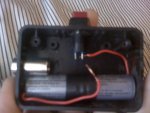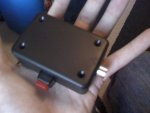Well, the AixiZ module itself is a heatsink.. But it might not be enough for long duty cycles..
I have several 16x reds, with no more heatsinking than an AixiZ module. It's ok for under a minute, but after that it gets hot. Blu Rays dissipate much less heat than that:
- A red at 300mA is dissipating around 0.7W of heat - 3V x 0.3A = 0.9W - 0.2W (output power) = 0.7W..
- A Blu Ray at 100mA will dissipate less heat than that, 0.4W of heat - 5V x 0.1A = 0.5W - 0.1W (output) = 0.4W <- slightly more than half of the red.
So a Blu Ray at a safe current is not gonna get as hot as a 16x red if both are only in an AixiZ module. In fact, you may not even feel it with your fingers.. But touch it with your lips and it'll feel quite hot.
The power drops for 4mW or so, and it would probably drop a bit more, if left on longer. If you want the power to be stable, you do need a heatsink. But just for protection of the diode, it might not be essential. They go through much more abuse inside a computer drive. On the other hand, heatsinking might prolong it's life a little.
Also since without heatsinking, you would need more current for a certain power, i am using aluminum heatsinks, to keep them cool. Especially, since i have a feeling many people will be leaving them on for minutes at a time. I most certainly do. Can't stop looking at it..

Oh, and 90mA can give you anywhere between 67 - 80mW after a clear acrylic lens. There would seem to be differences between individual diodes.
Dirt or dust on the lens can further reduce this by 4mW or so.
Once we have Blu Rays running at 200mA, they will get almost as hot as an open can tho, because of the higher voltage. There, heatsinking will be essential.





